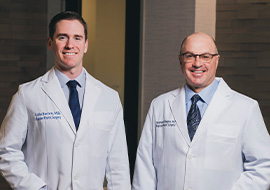Enucleation and Evisceration
Anophthalmic Surgery
Enucleation is the complete removal of the entire eye. This technique is required in all patients with known or suspected intraocular tumors. It may also be recommended if it can not be determined whether or not a tumor may be present in the back of the eye. In this technique the eye muscles are detached from the globe prior to removal of the eye, and the muscles are reattached to the orbital implant or to the material used to wrap or cover the implant.
Evisceration involves removal of the contents of the eye or globe leaving the sclera (white part of the eye) and the eye muscles in place. This technique is less disruptive to the orbit as dissection into the eye socket is minimized.
At the time of your consultation, Dr. Klapper or Dr. Bacorn will further discuss advantages and disadvantages of enucleation and evisceration to help you decide which technique is most appropriate for your condition.
Surgery can be performed with intravenous sedation but is typically performed with general anesthesia. The eyelids may be temporarily sewn together for 1-2 weeks to help minimize swelling and to prevent extrusion of the plastic conformer placed at the time of surgery. A patch is placed over the operated eye for a few days, then ice packs are applied. Some patients experience nausea during the first 24-48 hours following eye removal. This is generally controlled with suppositories or oral medications.
The Artificial Eye (Prosthesis)
The artificial eye covers the eye socket tissue and underlying (buried) orbital implant. Artificial eye-makers are referred to as Ocularists. Ocularists make a custom impression of a patient’s eye socket in order to obtain an ideal fit. The Ocularists hand paints the iris color to correspond to the patient’s normal eye. Fine red threads and other specialized techniques are utilized to simulate naturally appearing veins and arteries.
The artificial eye is typically fit 5-6 weeks following surgery or when the eye socket swelling has subsided.
Our office will help coordinate your care with the Ocularist. Central Indiana is fortunate to have access to some of the finest Ocularists in North America. Fitting of the prosthesis usually requires at least two visits with the ocularist. Specific instructions regarding regular prosthesis cleaning and maintenance are individualized and will be reviewed by the Ocularist and by Dr. Klapper or Dr. Bacorn. Annual follow-up with the Ocularist for cleaning and polishing is highly recommended. Replacement of the artificial eye may be necessary every 5 years or so. Annual follow-up with Dr. Klapper or Dr. Bacorn is also recommended to monitor eye socket health, prosthesis fit, and eyelid position.
Klapper Eyelid & Facial Plastic Surgery treats disorders, injuries, and other abnormalities of the eyelids, eyebrow, tear duct system, eye socket, and adjacent areas of the mid and upper face.

